Iron Man pulled on his Mark V Helmet. Finally, his suit was complete. Now it was time to go and prod some buttock, as he’d been on the receiving end of Klaw’s machinations for some time now.
He powered up his boots and took to the air. Swooping down on his enemy, he unleashed a frenzied attack, sending Klaw reeling. Just one more pass and the world will be a safer place.
‘Beep, Beep!’
What’s this? A problem at Stark Industries? Share prices are plummeting – Is someone leaking information? Damn! Iron Man exits left, saving the world will have to wait another day!
- Designer: Michael Boggs, Nate French, and Caleb Grace
- Publisher: Fantasy Flight Games
- Year Released: 2019
- Players: 1-4
- Playing Time: 45-90
- Ages: 14+
- Recommended Retail Price: £59.99
Marvel Champions: The Card Game, is Fantasy Flight Games’ latest release in the Living Card Game format. Is it as great as the Superheroes adorning the box? Or does it turn out to that its Alter-Ego is really just a bit of a wimp?
What’s in the box?
- Learn to play booklet
- Rules reference booklet
- 199 Player cards (Standard card game size 63.5 x 88 mm)
- 137 Encounter cards (Standard card game size 63.5 x 88 mm)
- 7 Reference cards (Standard card game size 63.5 x 88 mm)
- 30 status cards (Mini American size 41 x 63 mm)
- 62 Damage tokens
- 33 Threat tokens
- 5 Acceleration tokens
- 1 First player token
- 4 Player hit point dials
- 1 Villain hit point dial
- 16 All-purpose counters
How does it play?
If you’re familiar with how the game plays, then feel free to flip to Hero form and power through to, ‘So, what do I think?’
Here’s a very quick overview of the game, so not everything is included, it’s just to give you a feel for the game.
Setup
Each player selects a Superhero and forms their deck. To do this they take the Identity-specific deck and set aside the Hero’s identity card, Obligation card, and Nemesis deck. They then choose one of the four Aspect decks, and add this to their Identity-specific deck. To this they add the Basic cards and shuffle them all together.
Aspect and Basic cards can be added and removed using the deckbuilding rules (which I’m not covering in detail here), but the final Hero deck must contain between 40 and 50 cards inclusive.
Players place their Hero’s identity card in front of them, Alter-Ego side up, and set the hit points to their starting value, as indicated at the bottom of their identity card.
All the tokens and status cards are placed within reach of the players.
First player is determined and given the first player token.
Players select a Villain and decide which modular encounter set they are going to add to its encounter deck.
The Villain’s identity cards (I and II if playing a standard level game, II and III if playing expert) are placed in the center of the playing area, along side their main scheme deck.
Follow any setup instructions listed on the main scheme card, and set the Villains hit points to required amount, as indicated at the bottom of their identity card – this is usually an amount per player.
The players add their Hero’s Obligation cards to the Villain’s encounter deck, which is then shuffled and placed alongside the Villains identity card.
All players then draw a hand of cards, the number of which is indicated at the bottom of their identity card, and they may now resolve any Mulligans.
Gameplay
A round is broken into two phases, the player phase, and the Villain phase – all players act in the player phase.
During the player phase players take turns in player order, with the player holding the first player token going first.
There are a number of options open to the player:
- Change form. A player can flip over their identity card to change from Alter-Ego to Hero, or vice-versa. This can only be preformed once each turn.
- Play a card from their hand. To play a card from the hand its resource cost must be paid. The desired card is placed on the table and then the cost must be paid, either by discarding cards from the hand, by using any cards they have in play that generate resources, or any combination of these.
- Use their Hero’s basic skills. Recovery in Alter-Ego form, Thwart or Attack in Hero form. This exhausts the Hero/Alter-Ego.
- Trigger an Action ability. These are abilities that are indicated by the word ‘Action’ in bold, usually on a card in play. To trigger an Action the cost must be paid, which may involve generating resources, discarding counters, or exhausting a card. If the word ‘Action’ is preceded by a form state i.e. Alter-Ego, then the player must be in that form to trigger the Action.
- Ask another player for assistance. For example, a player could ask another to trigger an action card that they control, or if they have an event card, which may help them out. Alternatively a player can volunteer to help the current player.
All of the above options can be carried out in any order and repeatedly, as long as the cost can be met.
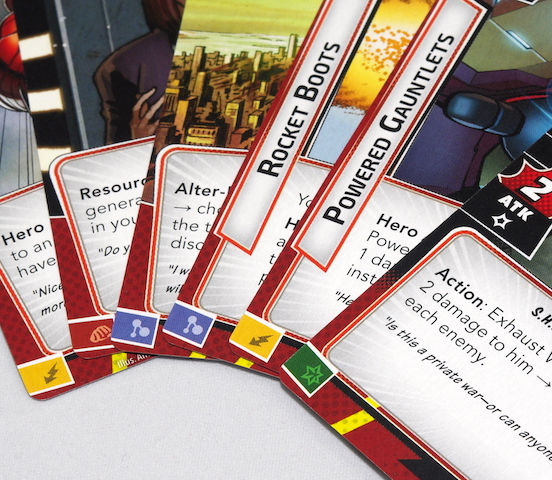
Some Actions require specific resources to be generated.
The final part of the Player Phase includes three steps:
- In Player order, each player discards any amount of cards, but must not hold a greater number than their current hand limit.
- All players then draw up to their hand limit.
- Each player readies any exhausted cards.
Villain Phase
Once all of the players have taken a turn, it is time for the Villain to act.
This phase is broken down into the following stages:
- Place Threat on the Main Scheme. Place the amount of threat as indicated on the Main Scheme card, this may be increased by acceleration tokens.
- The Villain and Minions activate. The Villain will activate once against each player, in turn order and any Minions attached to that player will also activate. If the player is in Alter-Ego form, the villain and Minions schemes. If in Hero form then they attack. (See below for further details.)
- One Encounter card is dealt to each player.
- Encounter cards are revealed and resolved. This is done one at a time and in player order.
- The first player token is passed on and the round ends.
When a Villain schemes, an encounter card is drawn form the deck and revealed. This is the boost card. At the bottom right of the card there may be boost icons present, and for each icon the villain gains +1 SCH for this activation. If a star icon is present, then there is an associated ability indicated on the card that must be carried out. The star itself does not boost scheming. The total amount of threat is added to the main scheme, which may result in that scheme advancing or trigger the end of the game.
For any engaged Minions with the current player resolving the activation, simply add threat to the main scheme equal to their SCH value.
When a Villain attacks, a boost card is again drawn but not yet revealed. The player must then decide whether to defend against the attack, either by exhausting their Hero, or an Ally they control. If the player does not wish to defend against the attack, then another player may step in to defend using either their Hero or an Ally they control.
The boost card is then revealed and this time is added to the attack value of the Villain. The result is then applied to the defender. Against a Hero the damage dealt is reduced by the Hero’s defence value. Against an Ally all damage is dealt to that ally. If undefended, then all damage is applied to the Hero that is resolving the activation.
All Minions then engaged against the resolving player will then attack, one at a time. No boost cards are drawn, and each attack can be defended against in the same manner as against the Villain. (Exhausted Characters can not defend again.)
PLayer’s win the game if they reduce the Villain to 0 Hit Points. The Villain wins if they complete their Main Scheme.
So, what do I think?
Components
Everything here is up to the usual standard of Fantasy Flight Games’ other living card games. The cards are all really good quality, with the artwork a delight for anyone who’s a fan of the comics, and all the information is easy clear and easy to read – I especially like the flavour text that crops up here and there, again a nod towards the comics.
The tokens are a good size – not too small that they’re fiddly, and not too large that they get in the way of the gameplay – and are good quality, punch-out, high-density grey board. The all-purpose counters are, as the name would suggest, used for keeping track of a variety of things, such as the number of snoops your surveillance team can do.
The hit point dials are a great addition, much better than using tokens to track your character’s health, and I use them for loads of other games too. The plastic push connectors that hold the dials in place were a little slack on one of my dials, and kept popping off, however, this was easily rectified with a spot of carefully placed glue.
Lastly, the box contains a segmented inlay for you to separate and store all your cards in, however, it doesn’t come with any dividers, so you’ll have to make your own!
Overall, the components are exactly what I expected them to be – good quality, great artwork, and clear and easy to use. So far there appears to be ample tokens in the box for you not to run out in a game.
Theme
I used to be a big fan of Marvel comics, right through the late 70’s and early 80’s, and though I have only read the odd comic or two since, I have never lost the love I have for them. This game takes me right back to my childhood, and puts a big smile on my face!
The artwork on the cards is mostly reflective of the more modern comic era, but there’s the odd one or two that look as though they could’ve come straight out of my childhood, such as the Treachery card, ‘Gang-Up’. The flavour text is also spot on, and I found myself reading everything I came across, usually nodding and thinking, ‘Yeah, that’s just right!’
With the game underway the theme continues to engulf you. The villain’s main schemes are entirely appropriate to the villain in question, as are their side schemes, which bring a sense of urgency to the play – accelerating the threat of the main scheme, intensifying the danger to the characters by increasing the encounters, or diverting attention to the side scheme by making it a priority – whilst their encounter deck develops the villain just as you’d expect from reading the comics. Rhino can charge into battle, enhance his ivory horn, and call upon his Hydra minions, all of which help to make it feel like you’re tackling as cunning and devious a villain as you are a courageous and fearless hero.
The heroes themselves come armed with all the powers you’d expect. Spider-Man can do a swinging web kick, backflip out of harm’s way, and use his Spider-Sense to avoid sticky situations. Iron-Man has to build his suit and Black Panther needs his upgrades – all add to a very thematic experience, with the end result making your character feel like the superhero he is.
The Hero’s Obligation card also adds to the thematic theme, as She-Hulk finds she has legal work to attend to, and Spider-Man finds he’s on the verge of eviction. The way these obligations work in game play is also thematic: She-Hulk has to flip to her Alter-Ego form and exhaust to remove the card from the game – you can easily imagine her being dragged away from chasing the villain because she needs to appear in court for an important case. If she chooses not to, then the scheme gets an acceleration token – her failure to pursue the legal case has leant a helping hand to the Villain – and the obligation goes into the discard pile, maybe to reappear at a later date.
Each Hero also has a Nemesis decks, which consists of five cards. The Nemesis, Vulture in Spider-Man’s case, turns up when instructed by an encounter card – the Nemesis himself, along with his side scheme, is placed straight into play, whilst the remaining cards are shuffled into the encounter deck. Though I found that these don’t get called into action very often, they do feel right for the story, especially when you think of the comics – Spider-Man’s in the act of bringing down Klaw, but just at the wrong moment up turns Vulture who has his own agenda, and get’s in his way and Klaw escapes this time!
It isn’t all about the characters that make the game thematic to play either; the game mechanisms do a fine job too. The option of having another player help out during your turn, possibly by playing an event card or triggering one of their actions, lends itself to the dramatic and selfless actions one associates with these heroes – it doesn’t come any better than having Luke Cage jump in front of you to take a hit!
Rules
As is the norm for Fantasy Flight Games there is a Learn to Play guide and a Rules Reference.
The learn to play guide steers you into the game pretty well by using pre-built starter decks. There isn’t a great deal to get bogged down with here – the turn structure is straightforward and uncomplicated, and there are suggested starter decks for all the core heroes and villains.
I found that the problems started when you get the cards in your hand. The basic rules are fine, but some of the cards got me questioning things, and I spent many a minute on BGG trying to get things straight.
I usually quite like FFG’s rule references, but this one is pretty poor. The index causes some confusion, for example: I wanted to know something about being in the Alter-Ego form, so I looked for Alter-Ego in the index – nothing – and neither is there a listing for Hero. The information is under ‘Form’, but it never occurred to me to look for that. As in past rules references I would have expected there to be an entry under Alter-Ego simply saying, see Form, it would have made things a lot quicker when searching for information – I found this kind of thing occurred far to often.
I also thought that the references weren’t written as precisely as they needed to be, and left some ambiguity. Take the ‘Empty Player Deck’ entry for example. This states that when you empty your deck, “… That player immediately deals themselves one card from the encounter deck.” Sounds simple, but I bet most players would instantly resolve this encounter, I know I did, when in actuality, this encounter doesn’t get revealed until stage 4 of the villain phase, reveal encounter cards. There was nothing in the empty player deck reference to highlight this fact, and I, along with many others it would seem, overlooked this.
Fortunately, there is a very useful FAQ’s being put together through BGG, though this shouldn’t really have been necessary if things had been properly addressed within the rules – I’ll put the link at the end of the review.
Once you’ve got a grip on the rules and can concentrate on the game, then things do flow really well, as the basic structure is pretty solid.
Gameplay
Disappointing!
That was my first reaction after playing solo whilst using the suggested starter decks – Spider-Man vs. Rhino. Fortunately, by the time I’d racked up a dozen or so games, and advanced up to facing Ultron, my opinion had, just like an out of control Spidey, swung in totally the opposite direction!
So, why the initial disappointment? Those first few games playing as Spider-Man or Captain Marvel, against the basic Rhino deck, I found to be far too easy. The character decks appeared very obvious in how to play them, and I didn’t encounter any particularly challenging decision-making. But, moving on from there and playing with Iron-Man, things began to change…
Let’s start with the characters.
It takes a few games to get the hang of each character, especially when to change form, and each has their own idiosyncrasies. The character’s identity-specific cards feature a whole host of useful abilities, all of which are thematically linked to the hero in question – event actions, upgrades and support cards, or allies one would typically find helping them out – and they combine to make that character feel powerful in their own unique way.
Some Heroes do feel easier to play than others, but that doesn’t mean they are necessarily easier to win with. Iron Man is possibly the most difficult to get to grips with from the core box, having to build up his suit of armour before you can properly engage the enemy, but once done he becomes the formidable fighting machine one would expect. Whereas I found Spider-Man, Captain Marvel, and She-Hulk far easier to grasp, though they still had their challenges.
With some of the Superheroes you build an ‘engine’ of support and upgrade cards, which can give a lot of satisfaction when they all come together for a game winning move. Iron-Man and Black Panther in particular are good for this, but both work in quite different ways. Getting Iron Man into the air can buff his powers, whilst you need a specific card to fire off Black Panthers upgrades, one after another, with the last one to take affect having its powers doubled.
The included basic card decks can be tailored slightly using the deck building rules to compliment the hero’s abilities, but they also work quite well using the suggested starter set up.
The aspect decks, which can also be tinkered with, though not by much without the inclusion of expansions, give an extra dimension to the character that compliments certain play-styles. The leadership deck, for instance, focuses on strengthening allies, whilst the Justice one is all about thwarting the villain’s schemes.
Playing with two or more players then it really pays to compliment each other’s abilities, both with the Hero’s identity-specific cards and the aspect each player chooses, and this opens up some interesting tactical decisions. Alternatively, go with what you enjoy playing, then, in true Marvel fashion, enjoy the ride in trying to make it work!
The three included villains, Rhino, Klaw, and Ultron, each offer their own set of challenges. Again there is a degree of deck building that can be done here, at least in terms of changing the encounter set.
Each villain has a suggested encounter set, but two more are included within the core box, and these can all be swapped around to suit your needs. You also get the option of playing each villain in expert mode by basically knocking their identity card up a level, and inserting a few ‘expert’ cards into their decks.
The villains encounter decks are each quite different from one another, and I found I had to adjust tactics to suit – you can’t totally stick to one method of playing a character and hope to beat all the villains, you have to adapt.
Having to pay for cards by discarding others works really well here. I’ve often found it a frustrating game mechanism, but I enjoyed playing it in this format. I was always presented with a hand of cards that was useful and, as you always want to make the most of each turn, it came down to deciding which cards to play that would cause the greatest impact without leaving me vulnerable – often a tricky decision to make.
The cards make you feel all-powerful, just as you would expect playing a superhero, and your first temptation is often the one that sees you doing what a hero should be doing, dealing massive amounts of damage to the enemy. But with a little more thought you see that this could leave you open to a counter attack, and you only have limited health left. So, what about flipping to your Alter-Ego side, this way you can regain some of that much needed life? Ah, but then the villain will be left to concentrate on their wicked schemes, and it’s surprising just how quick these can be brought to fruition.
It is this mechanism of changing form that creates a lot of the tension within the game; it’s a fine balancing act of fighting the villain and taking a breather to recover. As you reveal extra side schemes things get taut, main schemes may get accelerated, or you’re faced with extra encounters, and you need to be on the ball when it comes to deciding your priorities – can you kill the villain before he completes his scheme? Is it wiser to thwart him and build up a defence against his attacks? So many great choices to make!
The last thing I liked about the gameplay was the way that the turn structure really made it a co-operative experience. By simply having the players draw up and ready their exhausted cards after they had all taken a turn, meant that when you help out during another player’s turn, you are doing so with detriment to what you may be able to do during your turn – if you use most the cards in your hand, or your characters on the table, in helping out others, then you are going to be pretty limited in what you can do on your go. It really made it feel like you’re in it together.
Balance and scaling
In terms of difficulty the villain decks are reasonably flexible – you can bump them up to expert level, you can change the modular encounter set for a more difficult one, you can even try adding two, or more – so you should be able to find something that offers a suitable challenge.
The more you play, the better you will get, as you learn how to make the most of each hero’s deck, and if you start tinkering on the deck building side, then you may get to the point of seeing some easy victories. But I certainly haven’t reached that point yet, for me, a win against the more difficult opponents, feels like an achievement, and is often a close fought game.
In basic form, using the recommended starter decks, Rhino is pretty easy to beat, whilst Klaw and Ultron both offer a much more challenging game. These two decks play in quite different ways, and I found certain heroes, playing with certain aspects, fared much better against one or the other. For instance, I found Black Panther great against Ultron, where a certain upgrade card works really well – no spoilers, work it out for yourself!
As for player count, the balance of the game seems pretty good throughout the player range, though I preferred it 1 or 2 players, though to be honest I’ve only managed a handful of games at the higher player counts. I found that the decision making, as a team, was more fluid at lower player counts, as you’re not presented with so many different options – who’s going to concentrate on thwarting, who can take damage for someone else, can we do enough combined damage to take the villain out… and so on. This can slow the game down somewhat, though it does lead to some great tactical team play.
Replayability
With five Superheroes, interchangeable aspects, three villains along with five modular encounter sets, and a degree of other deck building options, there’s plenty in the core box to keep you occupied and coming back for more.
Add into this the regular release of expansions, then there’s a ton of replayability here. If you really enjoy tinkering with the deck building options, fine-tuning your heroes until they preform just how you’d like them to, then hours can easily disappear from your life!
Even if you’re not that way inclined, then the ease of simply swapping out the aspect decks, along with changing the villain’s encounter deck, means that replaying the game is fast and simple, and you’ll find it all too easy to say, ‘Oh, go on then, just one more game!’
Fun?
Marvel fans apply here!
Marvel Champions captured the feel of the comics in a way that made me feel like a kid again – Spider-Man taking on Rhino, back flipping his way out of trouble, and using his Enhanced Spider-Sense to counter the Villains treacherous plans – for me, this is Michelin starred fun on a plate!
Once I’d ironed out the initial niggles with the rules, then I found the gameplay uncomplicated and flowing, leaving the players to concentrate on their strategy and tactics, and above all, having fun.
Can I play it… all on my own?
I’ve played this game a lot solo, especially when I was first learning the game, and have thoroughly enjoyed the experience.
I like the fact that you can play it with a sole Superhero, and the game is balanced quite nicely for this, offering a really good challenge.
I found some Heroes lent themselves to solo play better than others, though it really comes down to the choice of which aspect deck they were paired with. This is all part of the fun, and leads to repeated play, as you swap and change the aspects and get a feel for how different it makes the Hero play.
Another big plus is the set-up and play time. It only takes a few moments to gather the appropriate decks together for your Hero and Villain, and the majority of games I played came in at around 40 minutes play time (less than 30 minutes for some, but stretching to a little over an hour against the more difficult Villain set-ups). This makes it currently one of my go-to solo games when I’ve just an hour to fill.
You can, of course, play with more Heroes, but I found anything more than two really slows things down and becomes fiddly, as you have to keep crosschecking to see if another hero can help out the one who’s currently taking their turn.
As a ‘more-often-than-not’ solo player, I like games that have a strong thematic feel but also require some thought on strategy, and this game provides both. The Villain’s scheme give things a running storyline, and the encounters build upon this – you can easily imagine yourself trying to thwart Klaw’s scheme to sell illegal weapons, having to deal with weapon runners popping up to confront you, and all the time being wary to keep out of the way of his Sonic Converter!
As for strategy, it’s a little different than playing with other players, you can’t look to others to protect your back. You have to be mindful of how you leave your Hero for the Villain phase – Alter-Ego and he’s going to scheme, often difficult to overcome when playing solo, and you don’t want to be forced into changing to this form at the wrong moment by low health. In Hero form you can defend, but this leaves your Hero exhausted, though this doesn’t mean they’re incapable, and a defensive stance is a good tactic if you have aggressive cards in your hand.
Recommended?
If you’re a fan of FFG’s other living card games then you’ll have a rough idea of what to expect here, but it has a few distinct differences – it’s like a stripped down, lean and mean version!
The game doesn’t have the depth of Arkham Horror’s LCG, it doesn’t have the locations, and the story is more what you make it than one driven by Agenda and Act cards. But it has pace and the feeling that you, as the player, are more powerful than the villains your taking on – or at least on a par – it’s just a case of lining ’em up for the sucker blow.
It’s also a little easier on the pocket. You won’t have to buy all the mini expansions to be able to complete a whole campaign, because at the moment there isn’t one (will there ever be?). You can simply purchase the expansion packs that interest you, Thor or The Green Goblin, for example, and I think this opens the game up to more people – and, of course, four players can play with just one core set!
In its standard form it isn’t the deepest of games, you’ll soon get used to the decks you’ve put together and the methods for playing the Heroes at their best, but even so, the game still offers a challenge and a lot of fun. If you really enjoy the deck-building side of things, and do purchase the expansions, then that will certainly add more depth to the proceedings.
If you’re a Marvel fan, then this is something you can’t afford to miss, and for anyone who likes co-op card games it most certainly deserves taking a close look at. I’ve thoroughly enjoyed my time playing the game, and solo, with its quick set-up and short(ish) play time, it’ll keep me coming back for more.
My experiences
Players: Best at 1 to 2 players, though 3’s not too bad either. 4-players stretch the time and isn’t so enjoyable.
Playing Time: Solo – As little as 30 minutes and up to just over the hour mark. 2-3 players, around the indicated time of 45-90 minutes, occasionally a little longer. 4 players – from the couple of games I played at this count, anywhere between 1-2 hours.
Ages: 10+ If they can get to grips with how the cards work and interact, then there’s no reason for them not to play.
Expect to pay: Around £45 (taken from www.chaoscards.co.uk at time of writing).
Read my, ‘One Year On’ thoughts HERE
Extras
Official site – Fantasy Flight Games
Recommended video review – Rhado Runs Through
BoardGameGeek page – Here
FAQ’s – Here


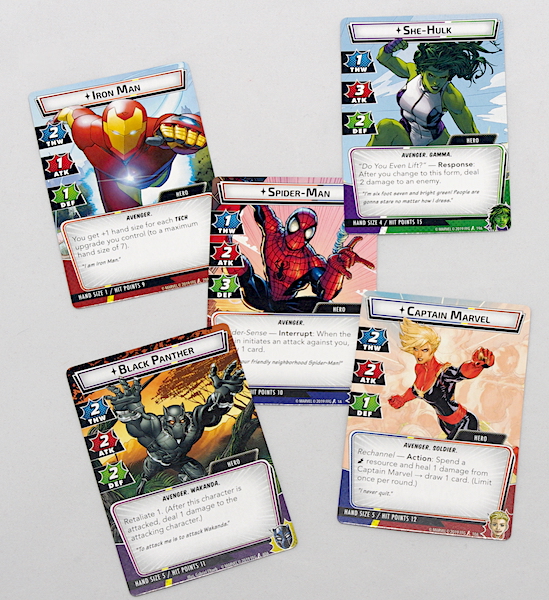

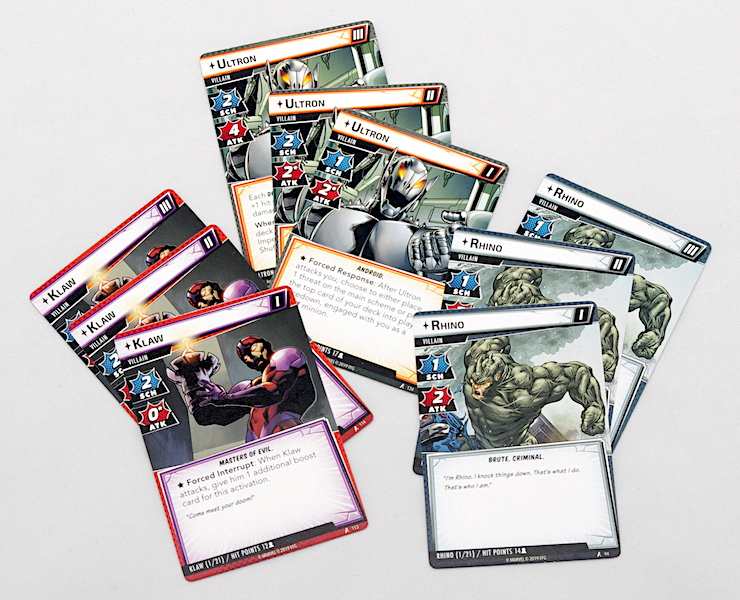
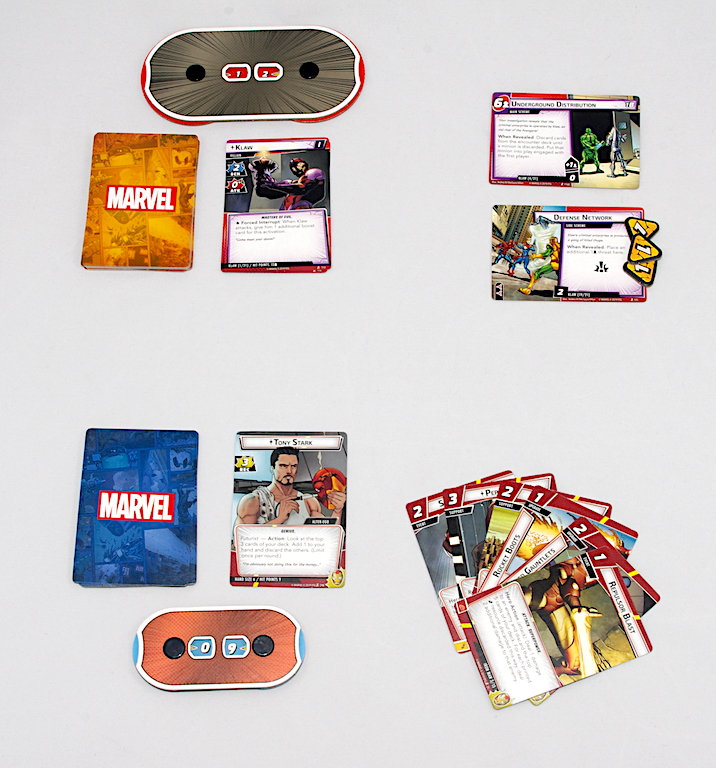


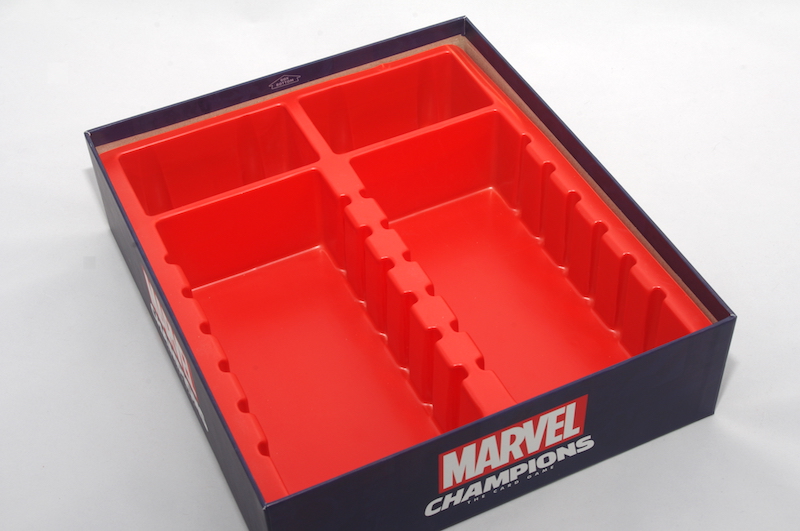

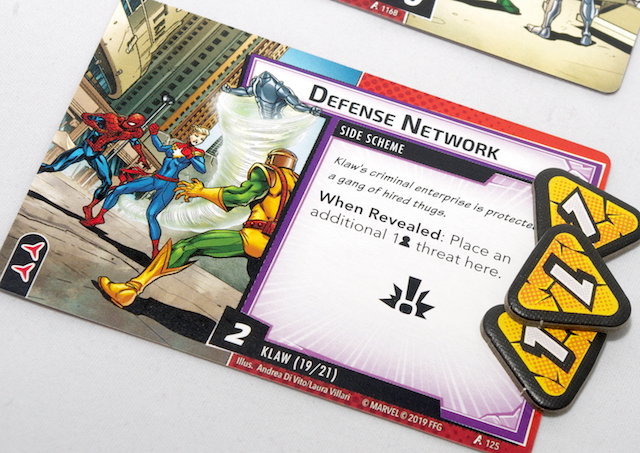
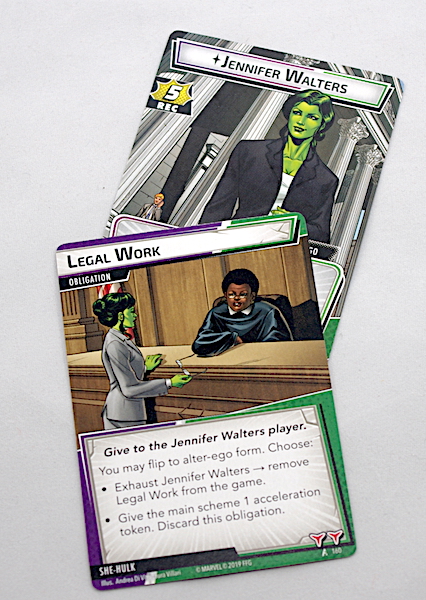

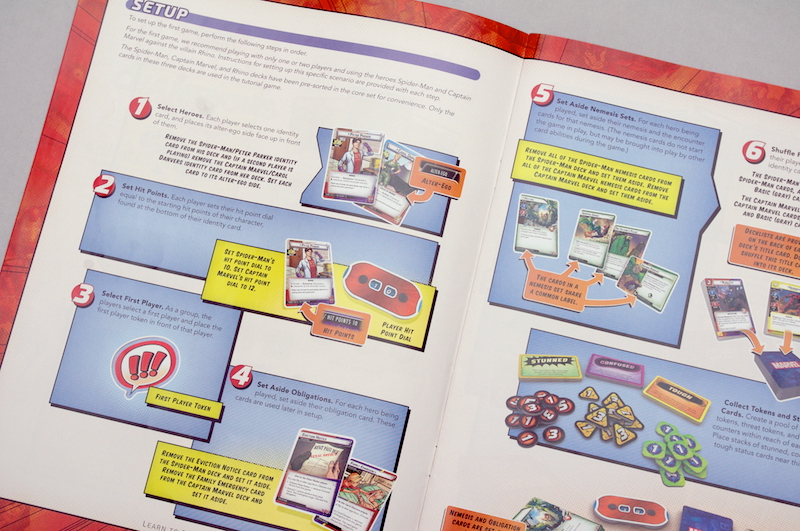



7 thoughts on “Marvel Champions: The Card Game”